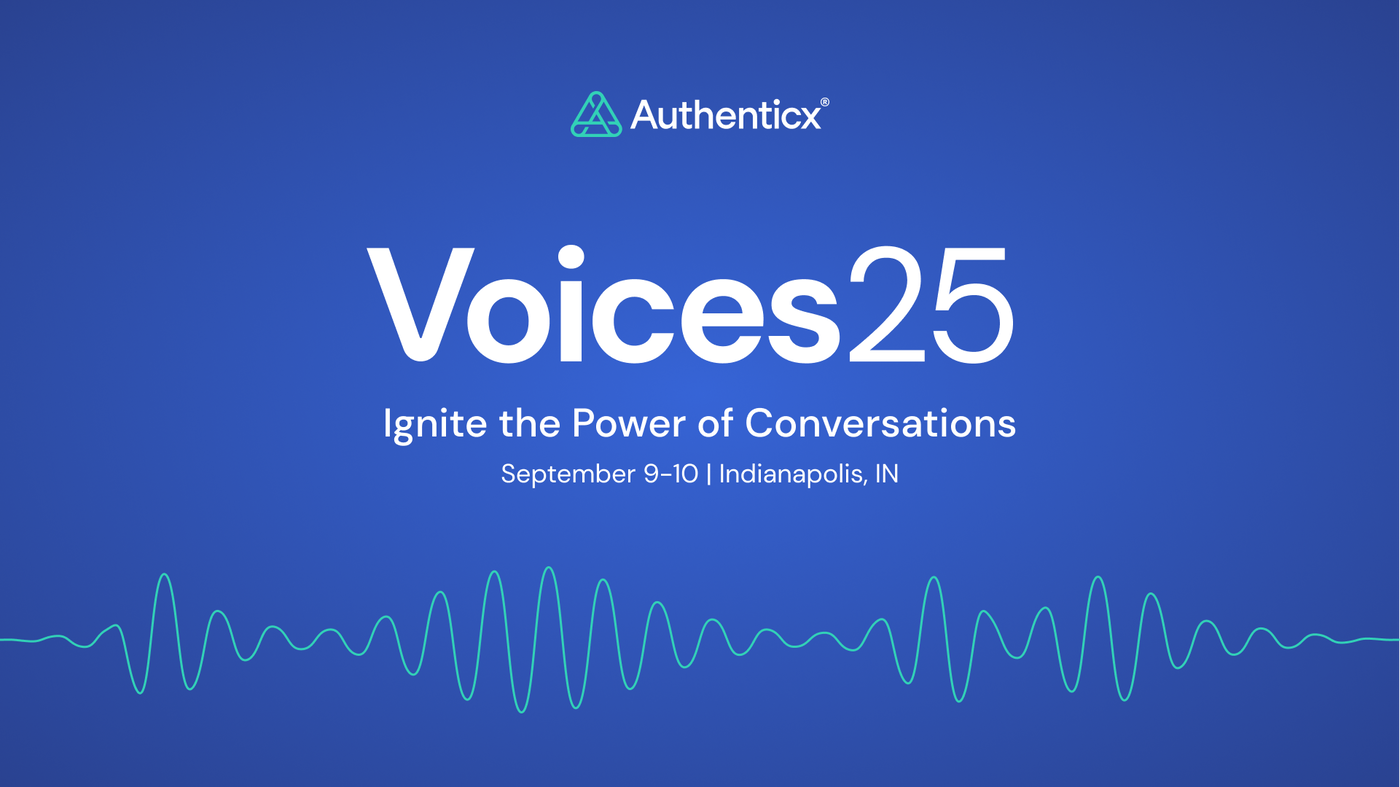
The landscape of digital solutions has grown exponentially over the past year with the rise in popularity of generative artificial intelligence (AI) tools, such as ChatGPT, Jasper, DALL-E, Alpha Code, Copy.ai, Jarvis, Synthesia, and many more. As generative AI traditionally uses machine learning (ML) algorithms built from large language models to create new, summarized content from text, code, or images. Although we often refer to our platform as conversational intelligence, Authenticx does have the same generative AI capabilities within our summarization model (Speech Analyticx) using artificial neural networks trained by unsolicited data.
Authenticx has been utilizing (and constantly improving) this type of AI in healthcare since its launch. Our more advanced models generate more data than traditional generative AI while also organizing and structuring data to refine our machine learning and provide enhanced insights for users. To best explain how Authenticx is equipped to provide insights from unsolicited data for healthcare conversations (like Medicare and Medicaid data), understanding each health insurance program is key to revealing the impact that AI can have on filling gaps in the complexities of healthcare customer experience.
Medicare: a federal, standardized health insurance plan for people 65+ years old that meet certain program conditions. This plan does not alter on a state-by-state basis.
Medicaid: a joint health insurance plan for those with limited resources or income that meet program conditions. This plan includes a base federal guideline but does have differences from state to state.
Why Medicare and Medicaid Need AI
Medicare and Medicaid data is inherently sensitive and often makes headlines each year during open enrollment. In the same vein, AI is seemingly everywhere – from the front-page news to tools we use every day. Using AI creates opportunities for reduction in administrative tasks for insurers (like Medicare and Medicaid) to focus on the member and their care (e.g., costs, satisfaction, and health outcomes). These tools accelerate how customers interact with their service while improving the overall customer journey.
Common gaps in the Medicare and Medicaid patient experience that AI and ML help close include:
- Personalized care: a personalized care plan brings the patient to the center of their own health rather than providing predetermined care from plan enrollment guidelines.
- Patient monitoring: common health issues and/or check-ins are more and more accessible via remote and digital (like a smartwatch or phone application) monitoring.
- Identity detection: claims, like fraud or misuse, can be more quickly identified and are better equipped to handle the influx of data.
- Predictive analytics: key data points can be analyzed from electronic health records (EHRs) and from social determinants of health (SDOH) in a population or by individual cases. Behavioral health is a subset of this metric, focusing on risk factors and interventions.
How is AI Working with Medicare and Medicaid?
There have been significant developments – negative and positive – in the utilization of AI in key aspects of Medicare and Medicaid data.
The use of AI, including by The Centers for Medicare and Medicaid Services (CMS), focuses on the process being transparent, ethical, and responsible. The goal of AI in healthcare is to minimize the risks of intelligent technology and maximize the benefits to health outcomes. As described in TechTarget RevCycleIntelligence, Google Health and the Mayo Clinic have ventured into using machine learning algorithms to improve patient outcomes around cancer and heart defects, respectively. Beyond this, according to a Wired article, CMS has used AI systems to better indicate strokes and diabetes. ML has also been used to identify fraud or abuse in Medicare and Medicaid programs, as specified in a conference study in IEEE International Conference on Machine Learning and Applications (ICMLA), enhancing the work for organizations to reallocate human resources elsewhere.
Using AI in healthcare has had complications with machine bias stemming from incomplete data sets that highlight the negative effects of AI misuse. As outlined in a Connected Health Initiative report, SDOH and public health issues can be common with Medicaid programs; for AI to be independent and develop safeguards, the performance must abide by a “Quadruple Aim” goal based on the Institute for Healthcare Improvement’s “Triple Aim”. This is also detailed in a study found in JMIR Mhealth and Uhealth reviewing SMS message alerts for prescription refills and patient demographics
To best utilize the benefits of AI, data needs to be accurate, relevant, and representative. Do the numbers match the impact? Similar to genetic ancestry, the output is only as robust as the input (the more people submit DNA for genetic testing, the more accurate and representative the data will be). In the same TechTarget RevCycleIntelligence article, analytics need to be up-to-date and mirror the expected population affected. So, how can intelligence models fill the gaps in care? Artificial intelligence can unlock the power to:
- Assess risk in care
- Highlight impacted populations (like SDOH)
- Detect fraud and/or abuse
- Measure outcomes/metrics
And we know it is not a perfect process. For instance, if AI is used to conduct and run medical coding (reducing administrative tasks), the machine should be trained on both historical and current data. If the data is outdated, the care is less personalized and the problems regarding SDOH and patient adherence start to become apparent as the analytics would mirror past member data and lack the representation and beliefs found in newer feedback that informs business decisions. AI can only fill the gaps it knows exists – so unlock data to tell the whole story of your members.

Get Medicare and Medicaid Insights, Not Numbers
For an intelligent system to account for previous miscalculations of care, the platform must be able to evolve with manual, human corrections. In turn, this equips leaders to best assess, and change programs as needed for strategic growth. Delving into unsolicited feedback can analyze, autoscore, and predict outcomes to steer business decisions. In addition, when that process is reviewed by human ears to understand context, tone, and sentiment, a holistic view of the care journey is seen.
The next evolution of healthcare fuses human understanding with the use of AI to accomplish several steps to improving the Medicare and Medicaid member experience:
- Locate areas of member retention, attrition, and adherence
- Resolve journey pain points by limiting bias from SDOH for representative insights
- Inform action with operations insights, like coaching and training opportunities
- Track and enhance security within the patient population
- Measure and identify trends in Stars ratings, as described by McKinsey & Company
- Monitor customized performance metrics (KPIs) to ensure a high quality of care
Authenticx was built from healthcare for healthcare. Our intelligence models are built from and analyzed by healthcare professionals. The complexities of the business of healthcare are accounted for when our teams give insights from the conversational data that already exists (and often aren’t leveraging). We give specific opportunities for personalized Medicare and Medicaid solutions that do more than show data points and charts. So, what can you do to improve this specific disruption our members are experiencing?
- Understand your members and their preferences
- Locate where they are and what barriers they’re facing
- Adapt to meet them as a guide to keep the journey going
AI Listens Differently to Medicare and Medicaid with Authenticx
Data is just the tip of the healthcare behemoth – knowing how to solve and activate your program holds the key to optimization. Authenticx is your healthcare solution to understanding barriers, performance, and successes in your Medicare and Medicaid patient experience. We are able to identify member pain points, improve agent training, classify and autoscore conversations, locate disruptions to reallocate resources, monitor specific programs, track quality scores, and predict member retention from collected data. We do this with our key features:
We listen at scale so we can help you have the best data insights to tell your patient stories. Medicare and Medicaid patients matter because the gaps of care and complexities within the business of healthcare often affect the most vulnerable and sensitive populations. It is our mission to help you understand each member, find where they are at, and keep the journey going. If personalized care is a gap to close, you should have personalized insights to better allocate resources, equip agents and leaders, and connect to patients. So, start now – schedule a meeting today to capture and measure your impact on healthcare. Your care never goes unnoticed.
For the most up-to-date changes and news about Medicare and Medicaid, please visit the Centers for Medicare & Medicaid Services (CMS). For more information on Medicare, go to this resource. For more information on Medicaid, go to this resource.

About Authenticx
Authenticx was founded to analyze and activate customer interaction data at scale. Why? We wanted to reveal transformational opportunities in healthcare. We are on a mission to help humans understand humans. With a combined 100+ years of leadership experience in pharma, payer, and healthcare organizations, we know first-hand the challenges and opportunities that our clients face because we’ve been in your shoes.
Want to learn more? Contact us!
Or connect with us on social! LinkedIn | Facebook | Twitter | Instagram | YouTube


